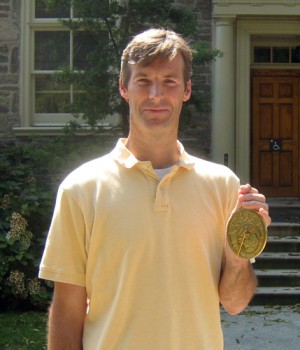The newest hand-held device on campus: a medieval-style astrolabe

Assistant Professor of the History of Science Darin Hayton with the College's new astrolabe.
Details
In the world of science, the latest technology usually rules. But students in Assistant Professor Darin Hayton's“Introduction to the History of Science” class will be getting some hands-on experience with a scientific instrument that originated in ancient Greece and had its heyday in the 16th Century.
It's called an astrolabe, and Hayton recently acquired one with the help of a Course Innovation/Renovation Grant from the Hurford Humanities Center. The instrument—an inscribed brass disk with moveable components—can determine the height of the sun and positions of various stars at a specific time and place, and can be used to tell time, calculate distances and construct an astrological chart.
Hayton says the device, which was made in Switzerland by craftsman Martin Brunold (one of only two or three astrolabe makers in the world) and modeled on a Gothic style astrolabe from 14th-century Iberia, will aid him in exploring a number of questions related to the history of science.
For one thing, says Hayton, the astrolabe illustrates how our understanding of abstract concepts, like time, can shift. Before our current method of dividing the day into 24 equal hours was universally adopted, people frequently also used a method known as seasonal, or unequal hours that counted the span between sunrise and sunset as 12 hours. Hayton's astrolabe, whose original design is from a period when the two systems existed side by side, can determine both types of time. “Another thing I want students to see is that categories like science and art are not mutually exclusive and the astrolabe is a good example,” says Hayton of the intricately worked, gleaming brass instrument, which resembles an over-sized piece of jewelry. In fact, Hayton believes that many astrolabes, ornate examples of which are housed in museums around the world, were likely used as much for decoration as calculation.
“I also want students to consider the question of what makes one activity scientific, and another not scientific,” says Hayton, who plans to use the astrolabe in a course he's developing called“Science and Technology in the Medieval World.” Says Hayton,“We are certain that astronomy is science and astrology is not. But for most people [in past centuries] astrology was the practical application of astronomy. In fact, my suspicion is that most astrolabes were used for astrological purposes.”
Remarkably versatile, astrolabes could, in principle, be used for a wide range of astronomical and terrestrial observations. However, Hayton, the author of a forthcoming book titled The Astrolabe: A Guide (Oxford, Museum of the History of Science), says he's not convinced by the volume of writings that arose around astrolabes, offering ever more complex uses for the instruments. (Among them: a treatise by Geoffrey Chaucer, written in 1391, that is considered the oldest technical manual in the English language.)
Says Hayton,“By the 16th century some of the texts ran to hundreds of pages. They explained how you could use an astrolabe to do things like calculate the depth of a well, determine the height of a tower or minaret or calculate how far away the enemy was on the battlefield. Yes, you could do it, but the question is, did anyone really use them that way? I can't really see someone walking out on a battlefield, holding up their astrolabe.”
—Eils Lotozo



